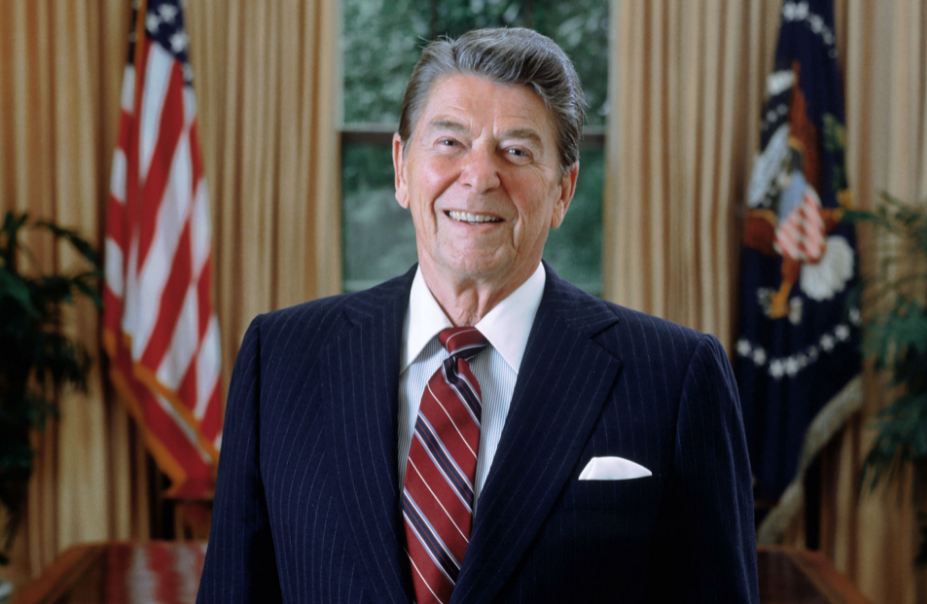Major Economic Policy
When Ronald Reagan became president, the economy was experiencing double-digit inflation and interest rates near 20%. Reagan promised during his campaign to free the market from heavy government restrictions and to foster private initiative and enterprise.
Reagan’s economic policy reflected his long-held opposition to high federal income taxes. Reagan believed in supply-side economics, believing that tax cuts would drive economic expansion, resulting in higher revenue for the federal government at a lower tax rate. Increased revenues would subsequently be used to boost defense spending and bring the federal budget back into balance. This general approach became known as “Reaganomics,” or voodoo economics, as Republican primary contender Vice President George H.W. Bush put it.
In addition, the President promised to protect essential entitlement programs (such as Medicare and Social Security) while decreasing the budgets for other social programs by focusing on waste, fraud, and abuse.
Ronald Reagan engineered the passage of $39 billion in budget savings into law during his first year in office, as well as a significant 25% tax cut for people spread over three years and speedier write-offs for capital expenditure for businesses. Simultaneously, he pushed on and was mostly successful in obtaining additional defense funding.
Even though inflation fell from 13.5 percent in 1980 to 5.1 percent in 1982, a severe recession set in, with unemployment topping 10% for the first time in forty years in October 1982. After two years, the administration changed its economic policy, proposing targeted tax increases and budget cuts to address mounting deficits and increased interest rates. Following the 1982 recession, the administration kept inflation under 5% for the rest of the administration, lowered interest rates, and increased discretionary income from tax cuts, resulting in record economic growth and considered as the lowest unemployment rates in the modern history of the United States, with unemployment reaching a 14-year low in June 1988.
The United States was in its sixth year of economic boom when Reagan departed office.
However, the economic improvements came at the expense of a record annual deficit and a soaring national debt. A trade deficit aggravated the budget deficit. The United States continued to buy more foreign-made items than it sold. On the other hand, Reagan remained committed to free trade and was the driving force behind the Free Trade Agreement with Canada, which later became the North American Free Trade Agreement or NAFTA. He also reluctantly approved trade legislation aimed at opening foreign markets to American goods.
Domestic Policies
Reagan’s domestic policies had and continue to have a significant impact on the American people. Following the passing of the most critical tax decrease in U.S. history, he supported and approved the 1986 Tax Reform Act into law. Reagan spearheaded the fight for a Social Security reform package that would ensure the system’s long-term stability and oversee the passage of immigration reform legislation and the expansion of Medicare to shield the elderly and disabled from “catastrophic” healthcare expenditures.
Reagan chose William Rehnquist as Chief Justice of the Supreme Court and three other justices: Anthony Kennedy, Antonin Scalia, and Sandra Day O’Connor, the first woman to be named. The New Right’s core principles included the notion that “judicial activism” was unconstitutional and that judges should be chosen based on “judicial restraint.” This concept guided Reagan’s court appointments.
Reagan got consistently high approval ratings. He was unpopular with several minority groups, particularly African-Americans, disproportionately affected by the economic boom. In 1986, more than 30% of the black population earned less than the official poverty level. While many labor leaders despised Reagan, particularly after dismissing air traffic controllers for refusing to strike in 1981, he was popular among union members.
Reagan pushed for creating “private sector initiatives” and federalism to delegate some of the federal government’s tasks to private businesses or state and local governments.
First Lady Nancy Reagan led the anti-drug campaign, pushing the nation’s children to “simply say no.” At the same time, President Ronald Reagan called for international collaboration to curb illegal narcotics, particularly cocaine, into the United States.
Foreign Policy
The prevention of communist spread in the world was at the center of Reagan’s foreign policy. Strong financial and military support for the Contras against the communist Nicaraguan government. The U.S. government gave another aid to the government of El Salvador in their fight against the communist guerrillas, as well as the U.S. invasion of Grenada in 1983 when that country was perceived to be under Cuban dominance, and support is given UNITA anti-communist fighters are all examples of this.
“The Reagan Doctrine” was the moniker given to these united efforts. While peace efforts in Central America stalled, the Soviets announced the withdrawal of troops from Afghanistan in 1988. Also, the Angola conflict was successfully resolved with the evacuation of Cuban soldiers.
When pro-US tyrants in Haiti and the Philippines appeared to be on the verge of being deposed, Reagan orchestrated their safe withdrawal from office, ensuring bloodless coups and a new administration that, he believed, would be pro-US.
In terms of Middle East politics, Reagan stated in his inauguration address that the 52 American hostages who had been kept hostage in Iran for 444 days were being released at the time and would soon be free.
The Iran-Contra incident would become known as the Reagan administration’s darkest hour. A special congressional hearings review board determined that Reagan authorized the sale of guns to Iran to assist in rescuing American hostages in Lebanon after extensive, nationally broadcast hearings. According to investigations, the proceeds from the arms transaction were unlawfully routed to help the Contras, Nicaragua’s opposition to the Sandinista government.
US Presidents | ||

